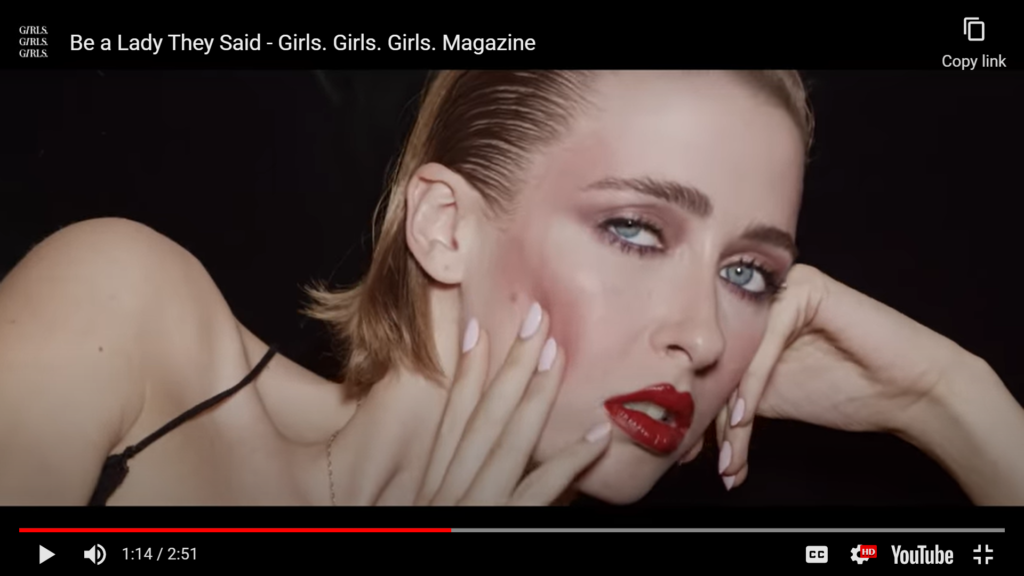By Reilly H.

Camille Rainville, who writes about her “thoughts, sentiments, and scribbles on womanhood” posted an original poem, “Be a Lady, They Said,” to her blog, Writings of a Furious Woman, in 2017.
It got a couple of hundred likes.
Three years later, in 2020, the online publication Girls Girls Girls picked it up and got big names like Cynthia Nixon, Rachel McAdams, and Vanessa Hudgens—as well as a plethora of models—to star in a visual representation of the poem.
It garnered over 20 million views.
Nixon narrates the poem in a firm voice as sensual images fill the screen. A woman in knee-high leather boots crosses her legs. A woman in red lipstick bites into a cherry. Rachel McAdams pumps breastmilk in a full face of makeup.
The Guardian called the images “hyper-glamorous” and “sexual.”
Impakter, an activist magazine, called the visuals, “divisive” and said it “generate[s] scandal” rather than creating a “constructive dialogue.”
The producer of the video, Claire Rothstein, maintains that “If the video wasn’t as stylized as it is, it wouldn’t have made the impression it has.”
To some extent, Rothstein is right. Women in exaggerated makeup, surrounded by opulence, posing seductively, etc., it all catches attention.
Interlaced with images of Donald Trump and Alexandria Ocasio-Cortez the words spoken in the film become inherently political. In short, it’s dicey, alluring, and a bit chilling.
Some people praised it. Some people condemned it. And while there is a lot that this video does well, when analyzed critically, there are significant cracks in its foundation.
Unfortunately, but not surprisingly, the film overtly plays into the patriarchy’s “ideal” beauty standards. It does so by casting primarily thin, white, cis-gendered, able-bodied women at its center.
This is deliberately leaving out the many other types of women that exist.
From women of color to trans women to women to plus-sized women….Rothstein seems to be reducing the experience of womanhood down to the perspective of primarily white women. This is nothing new and something that second-wave feminism got a lot of critique for.
While there are a small number of women that appear in the film that aren’t white, almost all of the big names that appear in the film are. Could this be a commentary on society itself? How white women are almost always bolstered to the top? It’s hard to say.
Furthermore, while Rothstein’s video has a point, and grabs the audience’s attention, it can be hard to fully support her when she says her vision, “flip[s] the male gaze and turn[s] it on its head.” While she does do a good job of taking “classic stereotypes that are considered negative” and spinning them into an “ironic” “hyper-real….fantasy,” as she told the Guardian, it can be hard to take her seriously when it is discovered that the film was directed by a man. Her husband, Paul McLean was the one behind the camera.
If she really wanted her work to be about female empowerment, it can be argued that she should have had a female director.
Better yet, in the spirit of inclusivity, she should be amplifying the voice of a lesser-known, non-white, female director. With a non-white woman behind the camera, it is reasonable to assume that the video itself would have been far more inclusive, assuming a director with that kind of background would speak up about working with a more diverse cast. While Rothstein’s films seek to do good and do include some women of color, it falls short of the mark.
Another problematic feature of this video is that it was largely inspired by Rainville’s words, and yet her name is nowhere to be seen in the video. The only place she is given credit is in a small attribution under the video on Vimeo and Youtube where it simply says:
Words: Camille Rainville
Other than this, her hand in inspiring the viral piece is largely swept under the rug. In fact, at the end of the video, the GIRLS GIRLS GIRLS logo appears, making it easy to infer that this publication was the mastermind behind everything–when it wasn’t. Without Rainville and her work, this piece wouldn’t exist.
As much as this video does a great job at bringing attention to the double standards that plague women in society, the predominantly white cast, the lack of a female director, and the lack of integrity around properly crediting Rainville expose the cracks in an otherwise beautiful piece of work.
While it is important to have media that calls out the patriarchy and the impossible standards women are held up to, we need this type of media to have a more diverse group of women at its center, working behind and in front of the camera, and we need to bolster the voices that make this work possible in the first place.
